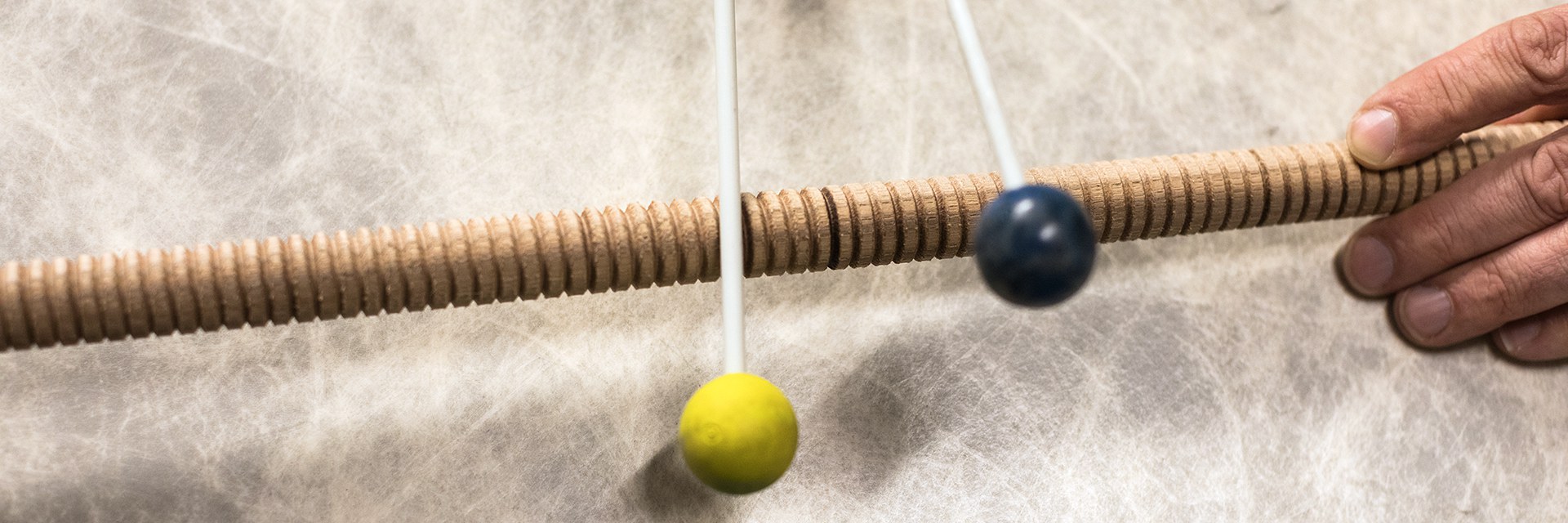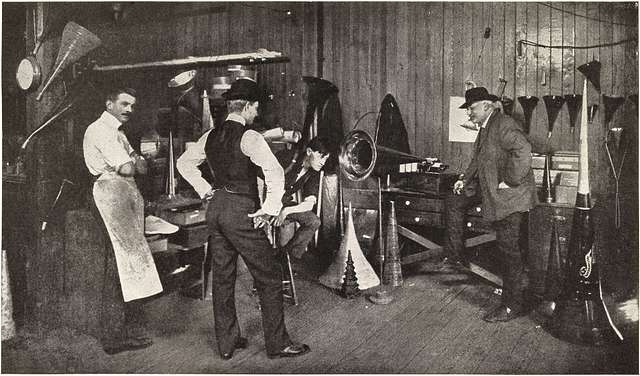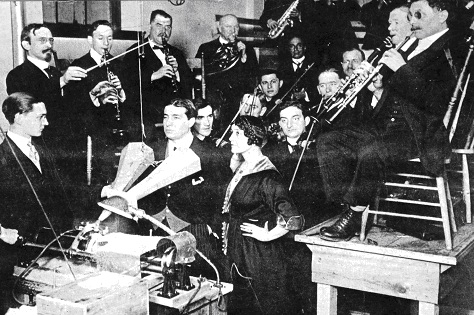
Voices in Wax
Recording the Acoustic Era
Voices in Wax explores the earliest developments in commercially-recorded music and phonograph recording technology (c.1885–1915) from a technical perspective, using hands-on experiments to contextualize historical recordings.

Edison workshop and experimental room ca.1900
The advent of music recording at the end of the nineteenth century forever changed the way music was consumed and performed. Recordings suddenly offered composers and performers a new way of projecting themselves into history. Therefore, especially for the fields of musicology and performance studies, it becomes key to address the earliest experimental period when the first recordings were made, in order to properly contextualize this material. Understanding how a recording was originally produced will help us to understand the impact of this technology, both on the performance itself and the development of musical styles during this period.
Hands-on Experimentation
This project will survey historical documentation regarding recording techniques and use this information as a springboard for hands-on experimentation with the machines themselves, systematically setting the parameters for creating recordings using original technology. Upon successful completion, this project will detail a standardized recording framework that can be used by future researchers in musicology and sound studies to produce comparable and repeatable recording results.
Swiss Phonograph Industry
The global origins of the recorded music industry are inextricably linked to the tradition of precision mechanics in Western Switzerland. The theoretical portion of the project will thoroughly catalogue developments in phonograph models produced by selected Swiss companies involved in the music industry from 1898–1908. Historical documentation of recording processes, including period recording instructions from around the world and photographs of recording studios, will also be taken into account.

Phonoscope wax cylinders. Zürich
Phonograph Recordings
The final stage of the project will use analyses of this historical information in the production of phonograph cylinder recordings using original equipment, while strictly controlling and documenting the various recording parameters. After determining the ideal material, acoustic, and mechanical properties for the recording session, three vocalists specializing in different styles of music (modern classic, jazz, and historical performance practice) will be recorded and the differences in their performances will be analyzed from a technical perspective.
The experience gained through this innovative and empirical approach to knowledge production will allow for a firsthand understanding of the limitations and possibilities of early sound technology and their influence on the performance practice of the music of this period and beyond. This research has the potential to change how we understand the relationship between musician and machine over the course of the crucial early decades of the twentieth century.

The tenor Lucien Muratore and the soprano Lina Cavalieri recording acoustically with an orchestra in the Pathé studio New York in 1916
Zum Forschungsprojekt
Dieses Projekt untersucht die frühesten Entwicklungen in der kommerziellen Musikaufnahme und der Phonographen-Aufnahmetechnik (ca. 1885-1915) aus einer technischen Perspektive, wobei praktische Experimente verwendet werden, um historische Aufnahmequellen zu kontextualisieren.
Voices in Wax bedient sich eines gemischten methodischen Ansatzes, der eine vergleichende Untersuchung historischer Quellen, qualitative Forschung auf der Grundlage von Interviews und systematische empirische Experimente mit Original-Aufnahmetechnik aus der Zeit um 1900 umfasst. In diesem Projekt wird ein standardisierter Aufzeichnungsrahmen festgelegt, der von künftigen Forschern in der Musikwissenschaft und in der Klangforschung verwendet werden kann, um vergleichbare und wiederholbare Aufnahmeergebnisse zu erzielen. In der letzten Phase des Projekts werden Aufnahmen auf Schallplattenzylindern mit Originalgeräten hergestellt, wobei die verschiedenen Aufnahmeparameter streng kontrolliert und dokumentiert werden. Nach der Bestimmung der idealen Material-, Akustik- und Mechanikeigenschaften für die Aufnahmesession werden drei Sänger:innen, die auf unterschiedliche musikalische Aufführungsästhetiken (moderne Klassik, Jazz und historische Aufführungspraxis) spezialisierte sind, aufgenommen und die Unterschiede in ihren Darbietungen aus technischer Sicht analysiert. Die Erfahrungen, die durch diesen innovativen und empirischen Ansatz zur Wissensproduktion gewonnen werden, ermöglichen es, die Grenzen und Möglichkeiten der frühen Tontechnik und ihren Einfluss auf die Aufführungspraxis der Musik dieser Zeit und darüber hinaus aus erster Hand zu verstehen. Diese Forschung hat das Potenzial, unser Verständnis der Beziehung zwischen Musiker:innen und den frühen Aufnahmetechnologien in den entscheidenden ersten Jahrzehnten des zwanzigsten Jahrhunderts neu zu denken.

Pathé advertisement Ca. 1908
The role of women in the phonograph & gramophone industries
In addition to the SNF founded project Voices in Wax, Áurea is also working on a study supported by the City of London Phonograph and Gramophone Society Richard Taylor Bursary Grant 2023. This research explores the key role that women played in the early development of the recorded music industry, focusing on the period between the 1890s, when Edison’s phonograph first experienced commercial success, until the Great Depression of the early 1930s.
https://www.clpgs.org.uk
Forschungsschwerpunkt
Historische Musikpraxis / Kommunikation Mensch & Maschine
Forschungsfelder
Early sound technology, Source criticism, recording technologies, Historical recordings, Gender studies
Forschungsteam
Projektdauer
1.1.2024–31.12.2024
Finanzierung
Schweizerischer Nationalfonds. Programm Spark
